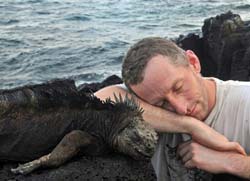Darwin in the genome

A current controversy raging in evolutionary biology is about whether adaptation to new environments is the result of many genes, each of relatively small effect, or just a few genes of large effect. A new study published in Molecular Ecology strongly supports the first “many-small” hypothesis.
McGill University professor Andrew Hendry, from the Department of Biology and the Redpath Museum, and evolutionary geneticists at Basel University in Switzerland, studied how threespine stickleback fish adapted to lake and stream environments in British Columbia, Canada.
The authors used cutting-edge genomic methods to test for genetic differences at thousands of positions (“loci”) scattered across the stickleback genome. Very large genetic differences between lake and stream stickleback were discovered at more than a dozen of these loci, which is considerably more than expected under the alternative “few-large” hypothesis.
By examining four independently evolved lake-stream population pairs, the researchers were further able to show that increasing divergence between the populations involved genetic differences that were larger and present at more and more loci.
As these results were obtained using new high-resolution genetic methods, it is conceivable that previous perceptions of adaptation as being a genetically simple process are simply the result of a bias resulting from previous lower-resolution genomic methods.
“I suspect that as more and more studies use these methods, the tide of opinion will swerve strongly to the view that adaptation is a complex process that involves many genes spread across diverse places in the genome,” says Prof. Hendry.
To read the full paper: http://onlinelibrary.wiley.com/doi/10.1111/j.1365-294X.2012.05509.x/abstract
Media Contact
More Information:
http://www.mcgill.caAll latest news from the category: Life Sciences and Chemistry
Articles and reports from the Life Sciences and chemistry area deal with applied and basic research into modern biology, chemistry and human medicine.
Valuable information can be found on a range of life sciences fields including bacteriology, biochemistry, bionics, bioinformatics, biophysics, biotechnology, genetics, geobotany, human biology, marine biology, microbiology, molecular biology, cellular biology, zoology, bioinorganic chemistry, microchemistry and environmental chemistry.
Newest articles

Simplified diagnosis of rare eye diseases
Uveitis experts provide an overview of an underestimated imaging technique. Uveitis is a rare inflammatory eye disease. Posterior and panuveitis in particular are associated with a poor prognosis and a…

Targeted use of enfortumab vedotin for the treatment of advanced urothelial carcinoma
New study identifies NECTIN4 amplification as a promising biomarker – Under the leadership of PD Dr. Niklas Klümper, Assistant Physician at the Department of Urology at the University Hospital Bonn…

A novel universal light-based technique
…to control valley polarization in bulk materials. An international team of researchers reports in Nature a new method that achieves valley polarization in centrosymmetric bulk materials in a non-material-specific way…





















